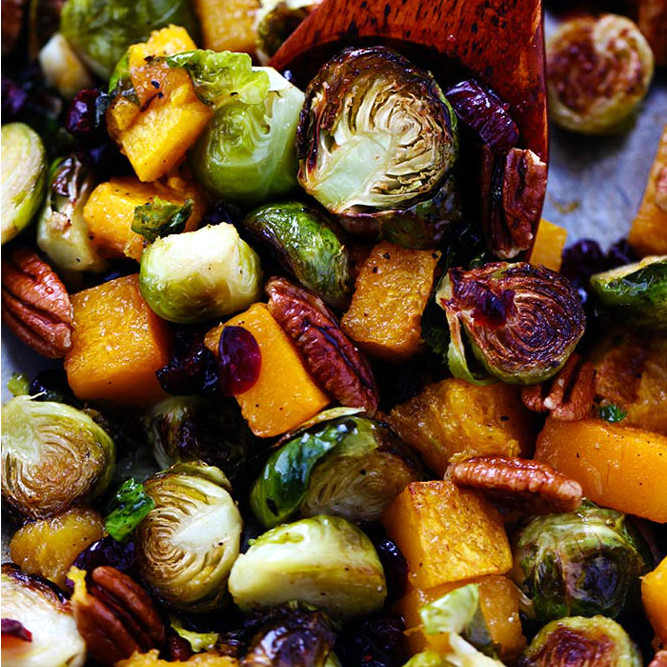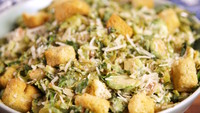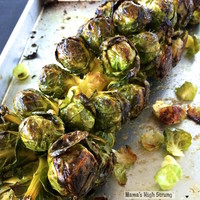Brussels sprouts deserve better
In 2008, Heinz took a survey of thousands of Americans and discovered that Brussels sprouts were the most hated vegetable in America, even more hated than broccoli.
Who can blame them? Brussels sprouts can be bitter, and the texture is often unappealing —especially to kids. So why is this cabbage relative suddenly turning up on restaurant menus everywhere? I’ll get there in a minute.
First, some history.
The Brussels sprout was probably first cultivated somewhere around the early 13th century in, of course, Belgium, for which it is named. It is hypothesized to have originated in or near Iran. The vegetable is part of the Brassica family and is closely related to broccoli, cabbage and kale. The sprouts are actually buds that will flower if left alone.
For centuries, Brussels sprouts were more medicine than food. They were thought to be good for digestion and illnesses as they contain a lot of vitamin C, fiber and anti-cancer phytochemicals. In European folk medicine, boiled sprouts were wrapped in cabbage leaves as a poultice for all kinds of ills and injuries.
When the sprouts came to America, they were reviled by immigraants. They stank up the kitchen and the entire tenement as women boiled them to a mushy consistency that ensured no one would enjoy them. This singular method of cooking persisted into the 20th century — I clearly remember my mother doing exactly that in the 60s. Ugh!
Fast-forward, and a change in cooking methods suddenly changed this lowly globe from reviled to beloved. People discovered that there were other ways to cook the little cabbages. You could roast them, fry them and bake them. You could peel off the leaves and oven-fry them into crunchy, healthy chips. You could make a Caesar salad, or drizzle them with maple syrup or sweet vinegars and add pastrami, cranberries, nuts and more.
These exciting new recipes enticed restaurants to add Brussels sprouts to their vegetable offerings. They first showed up on restaurant menus in the second decade of the 2000s, often roasted with bacon. The American public loved them, and kosher restaurants needed a way to compete. Fake bacon was unimpressive, so other meats were chosen: kosher sausages, corned beef and pastrami. An entire industry revolved around kosher recipes that used sprouts! Now they are commonly seen in kosher restaurants and are offered in many different forms by kosher caterers everywhere.
Brussels sprouts are now my favorite vegetable. They are healthful and versatile, and even my 2-year-old grandson loves them! Try these recipes out. You might find one you really like that will help you forget that stinky mush of your childhood.
Roasted Brussels Sprouts with Maple Glazed Pastrami and Shallots (meat)
2 lbs. Brussels sprouts, washed, trimmed and cut in slices
2 to 3 Tbsp. Extra-Virgin Olive Oil
1/2 tsp. salt
1/2 tsp. black pepper
3 to 5 shallots, peeled, thinly sliced
1/3 to 1/2 pound pastrami, cut into 1/2-inch pieces
1/4 cup pure maple syrup, dark amber
1 Tbsp. dark brown sugar, slightly rounded and firmly packed
Optional: A tiny pinch of red pepper flakes or cayenne pepper.
Preheat the oven to 425 degrees. Line a large rimmed baking sheet with foil. Set aside. Place sprouts in a large bowl and toss with olive oil, shallots, salt and pepper. Place in a single layer on the baking sheet. Roast in the oven until charred spots appear, about 20 minutes. Remove from the oven.
While the sprouts are roasting, cut the pastrami and place in the bowl the sprouts were in. Mix the brown sugar into the maple syrup in a small bowl until well combined. Pour over the pastrami and toss to coat. Set aside.
Remove the sprouts from the oven and spread the pastrami mixture evenly over them, mixing into the sprouts as you go. Scrape out all the syrup, drizzling over the sprouts. Place back into the oven and roast for 10 to 15 minutes, scraping once or twice to loosen from the pan.
When the pastrami is sizzling and the sprouts are charred in lots of places, remove from the oven. Let cool a bit and scrape into a serving bowl. Serves 6 to 8.
Roasted Brussels Sprouts with Butternut, Balsamic and Cranberries (Pareve)
1 to 2 lbs. Brussels sprouts, sliced in 1/4 inch slices
1 to 2 lbs. butternut squash, cut into 1/2-inch cubes
Salt and pepper to taste
1/2 to 3/4 cup dried cranberries
1/2 cup pine nuts, or chopped walnuts or pecans
2 to 3 Tbsp. extra virgin olive oil
1/8 to 1/4 cup excellent quality, thick balsamic vinegar
1 tsp. to 1 Tbsp. honey (optional)
You can substitute pure maple syrup for the balsamic vinegar if you like. For a kick, add a tiny pinch of cayenne.
Preheat the oven to 425 degrees. Line a large rimmed baking sheet with foil. Set aside.
Slice the Brussels sprouts (or buy them pre-sliced) and place in a large bowl. Cut the butternut squash and place in the bowl. Add olive oil and toss to coat evenly. Pour onto the prepared pans and spread evenly. Sprinkle with salt and pepper.
Place in the oven and roast until charred in places and the squash is fork tender, 20 to 30 minutes. Remove from the oven and sprinkle evenly with the cranberries, pine nuts or other nuts. Place back in the oven for 5 to 7 minutes. Remove from the oven and scrape into a serving bowl.
Meanwhile, mix the balsamic vinegar with the honey for a sweeter taste, if desired. Drizzle with the Balsamic vinegar, toss and serve. Serves 6 to 12, depending on amounts used.
Roasted Brussels Sprouts on the Stalk (Pareve)
1 stalk Brussels sprouts
1/2 cup extra virgin olive oil
1 clove garlic, finely minced
Salt and black pepper, to taste
Optional: Smoked paprika, regular paprika, and any other spice you like
Line a large, rimmed baking sheet with foil. Set aside. Preheat the oven to 375 degrees. Mix the minced garlic with the olive oil in a small bowl and set aside.
Wash and dry the stalk of Brussels sprouts. Place on the baking sheet.
Brush the sprouts evenly with the oil, sprinkle with the salt, paprika and pepper and place in the oven. Roast for 20 to 30 minutes, until the sprouts are charred in many places. Remove from the oven, carefully turn the stalk (I use a folded dish towel and an oven mitt) and return to the oven. Roast another 15 to 30 minutes, until the second side is charred in places.
Remove from the oven and cut the sprouts from the stalk, or let the family cut as they like. They will easily cut right off the stalk. Serve with a simple dipping sauce, such as ranch dressing or Caesar.
Homemade Caesar Dressing (Dairy)
1 to 2 small garlic cloves, finely minced
2 to 3 Tbsp. freshly squeezed lemon juice, to taste
1 tsp. Dijon-style mustard, to taste
1 tsp. Worcestershire sauce, to taste
1 cup good quality mayonnaise, regular or low-fat
Optional: 1 tsp. anchovy paste
1/2 cup freshly grated Parmigiano cheese
Freshly ground black pepper
Note: You can substitute Greek yogurt for some of the mayo for a tangier dressing.
Place the garlic, anchovy paste and lemon juice in the bowel of food processor and pulse to blend. Scrape down the bowl and add the mustard, and Worcestershire sauce. Pulse to blend. Add the rest of the ingredients and pulse just once or twice to blend. Scrape into a bowl and mix to blend. Add the cheese and mix and season with pepper to taste. Taste and adjust flavors as desired. Makes about 1-1/2 cups.

 45.0°,
Mostly Cloudy
45.0°,
Mostly Cloudy 









